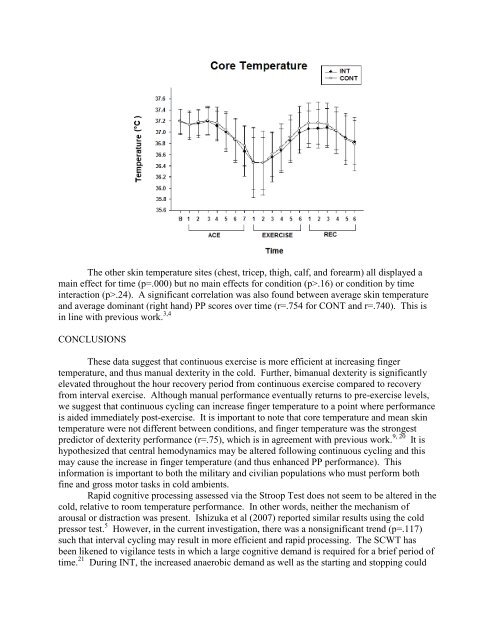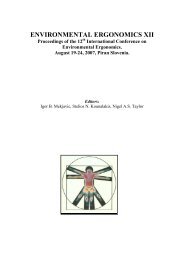Matthew D. Muller.pdf
Matthew D. Muller.pdf
Matthew D. Muller.pdf
Create successful ePaper yourself
Turn your PDF publications into a flip-book with our unique Google optimized e-Paper software.
The other skin temperature sites (chest, tricep, thigh, calf, and forearm) all displayed a<br />
main effect for time (p=.000) but no main effects for condition (p>.16) or condition by time<br />
interaction (p>.24). A significant correlation was also found between average skin temperature<br />
and average dominant (right hand) PP scores over time (r=.754 for CONT and r=.740). This is<br />
in line with previous work. 3,4<br />
CONCLUSIONS<br />
These data suggest that continuous exercise is more efficient at increasing finger<br />
temperature, and thus manual dexterity in the cold. Further, bimanual dexterity is significantly<br />
elevated throughout the hour recovery period from continuous exercise compared to recovery<br />
from interval exercise. Although manual performance eventually returns to pre-exercise levels,<br />
we suggest that continuous cycling can increase finger temperature to a point where performance<br />
is aided immediately post-exercise. It is important to note that core temperature and mean skin<br />
temperature were not different between conditions, and finger temperature was the strongest<br />
predictor of dexterity performance (r=.75), which is in agreement with previous work. 9, 20 It is<br />
hypothesized that central hemodynamics may be altered following continuous cycling and this<br />
may cause the increase in finger temperature (and thus enhanced PP performance). This<br />
information is important to both the military and civilian populations who must perform both<br />
fine and gross motor tasks in cold ambients.<br />
Rapid cognitive processing assessed via the Stroop Test does not seem to be altered in the<br />
cold, relative to room temperature performance. In other words, neither the mechanism of<br />
arousal or distraction was present. Ishizuka et al (2007) reported similar results using the cold<br />
pressor test. 5 However, in the current investigation, there was a nonsignificant trend (p=.117)<br />
such that interval cycling may result in more efficient and rapid processing. The SCWT has<br />
been likened to vigilance tests in which a large cognitive demand is required for a brief period of<br />
time. 21 During INT, the increased anaerobic demand as well as the starting and stopping could
















